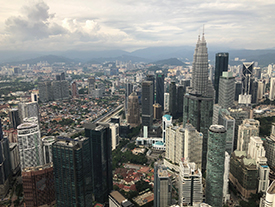ODA Topics 5
Look East Policy and Japan’s ODA as Key Drivers of Malaysia’s Socio-Economic Development
—Building on 40 years of accomplishments we have made together—

Kuala Lumpur’s cityscape, as seen from KL Tower

Providing guidance at MJIIT
The year 2022 marks the 40th anniversary of the launch of the Look East Policy in Malaysia. The Look East Policy aims to promote economic and social development and the establishment of an industrial base by sending students and government officials to Japan for study and training so that Malaysians can learn about Japanese work ethic, enthusiasm for working, morals, management skills, etc. The Government of Japan has consistently cooperated with the Look East Policy over the 40 years since its introduction.
For example, regarding study abroad programs, Japan supports international students so that they can adjust smoothly to classes in Japan by dispatching instructors to provide preparatory Japanese language education for them. With regard to training for government officials, Japan provides the Industrial and Technical Training Program, in which young government officials receive practical training at Japanese companies, and a training program targeting government high-level officials in managerial positions, in which they participate in training at local governments and private-sector companies in Japan. In addition, since 2015, Japan has provided training in areas such as cutting-edge industrial technology under the Look East Policy 2.0, which was established as the second phase of this Policy.
To date, the Government of Malaysia has sent approximately 26,000 students and government officials to Japan. As of the end of December 2021, over 60% of the Under-Secretary level officials of Malaysian government ministries and agencies have experienced studying or training in Japan.
In addition to the support for the Look East Policy, the Government of Japan has assisted with long-term planning and development of basic infrastructure such as roads, electric power, and water works through ODA, as well as improvements of industrial technology, for the socio-economic development of Malaysia. Japan has also supported industrial human resources development in Malaysia, including at the Centre for Instructor and Advanced Skills Training (CIAST)*1 in the 1980s and most recently, at the Malaysia-Japan International Institute of Technology (MJIIT), which was founded as a university that carries out Japanese-style engineering higher education, including through sending experts from Japan (see also “Promoting Science, Technology and Innovation, and Research and Development” for MJIIT). The focus of Japanese assistance has shifted from vocational training to higher education, in line with Malaysia’s economy and society.
These efforts that combine the Look East Policy with Japan’s ODA represent the characteristics of Japan’s development assistance, which respects the ownership of partner countries based on Japan’s experience and knowledge, in order to provide support that is suitable for the actual situation and needs of partner countries. Malaysia’s economy and society have developed smoothly through these efforts.
Furthermore, those who had been dispatched to Japan for study or training under the Look East Policy and returned to Malaysia make full use of what they learned in Japan by working in Japanese companies or by making policy as government officials, contributing not only to the Malaysian economy but also to mutual understanding and promotion of friendship between the two countries. The multi-layered human resource exchange fostered by the Policy has also supported Japanese companies in their investment and expansion into Malaysia. There are approximately 1,500 active Japanese companies in Malaysia, as of December 2021.
In this way, it can be said that the Look East Policy, while being a policy unique to Malaysia, is a project that Malaysia and Japan have created and implemented together. The Government of Japan will continue to collaborate with the Look East Policy and provide support for socio-economic development in Malaysia, which aims to become a high-income country by 2025. Japan, working together with the Government of Malaysia, will utilize the achievements of the Look East Policy over the last 40 years and ODA in order to promote cooperation with other countries, through efforts such as South-South cooperation.*2
*1 Japan provided support from August 1982 to March 1991, with the aim of developing specialist workers. 10,826 people received training up to the end of 1993.
*2 See the glossary.
